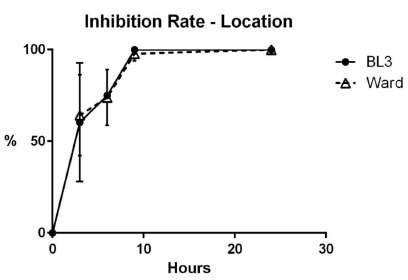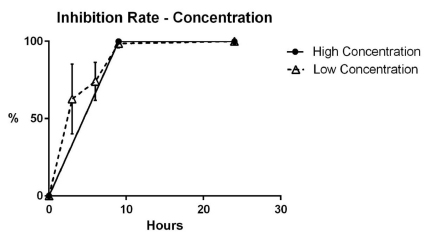Korean J healthc assoc Infect Control Prev.
2018 Dec;23(2):80-85. 10.14192/kjhaicp.2018.23.2.80.
Inactivation Efficacy of a Non-thermal Atmospheric Pressure Plasma Generator against Mycobacterium tuberculosis
- Affiliations
-
- 1Clinical Research Center, Masan National Tuberculosis Hospital, Changwon, Korea.
- 2Institute of Environmental and Industrial Medicine, Hanyang University, Seoul, Korea.
- 3Masan National Tuberculosis Hospital, Changwon, Korea. stoptb@korea.kr
- KMID: 2430272
- DOI: http://doi.org/10.14192/kjhaicp.2018.23.2.80
Abstract
- BACKGROUND
Tuberculosis is an infectious disease, -spreading from person to person through the air. When a person with infectious tuberculosis coughs or sneezes, tiny particles containing Mycobacterium tuberculosis are expelled into the air and remain suspended for several hours. Therefore, it is important to control the transmission of M. tuberculosis through air. This study was conducted to determine the inactivation efficacy of the plasma generator against the M. tuberculosis.
METHODS
The attenuated M. tuberculosis H37Ra inoculated on the solid medium were placed in hospital wards and BL3 laboratory, with a plasma generator (Model TB-500, Shinyoung Airtech, Seongnam-si, Korea) being operated at specific time intervals. The growth of M. tuberculosis was determined by plasma exposure time.
RESULTS
M. tuberculosis samples exposed to non-thermal plasma for 3, 6, 9, and 24 h showed inhibition effects of 45-75%, 69-86%, 93-100%, and 100%, respectively. Thus, it was found that the inhibition effect of plasma generators against M. tuberculosis were proportional to the plasma exposure time.
CONCLUSION
The non-thermal atmospheric pressure plasma generator technique may be applied as a promising technique for the prevention of M. tuberculosis infection in healthcare and other public facilities, when operated for more than 9 h.
Keyword
MeSH Terms
Figure
Reference
-
1. Health Quality Ontario. Air cleaning technologies: an evidence-based analysis. Ont Health Technol Assess Ser. 2005; 5:1–52.2. Bär W, Márquez de Bär G, Naumann A, Rüsch-Gerdes S. Contamination of bronchoscopes with Mycobacterium tuberculosis and successful sterilization by low-temperature hydrogen peroxide plasma sterilization. Am J Infect Control. 2001; 29:306–311.
Article3. Kyi MS, Holton J, Ridgway GL. Assessment of the efficacy of a low temperature hydrogen peroxide gas plasma sterilization system. J Hosp Infect. 1995; 31:275–284.
Article4. Venezia RA, Orrico M, Houston E, Yin SM, Naumova YY. Lethal activity of nonthermal plasma sterilization against microorganisms. Infect Control Hosp Epidemiol. 2008; 29:430–436.
Article5. Lloyd G, Friedman G, Jafri S, Schultz G, Fridman A, Harding K. Gas plasma: medical uses and developments in wound care. Plasma Process Polym. 2010; 7:194–211.
Article6. Steenken W, Oatway WH, Petroff SA. Biological studies of the tubercle bacillus : III. Dissociation and pathogenicity of the R and S variants of the human tubercle bacillus (H(37)). J Exp Med. 1934; 60:515–540.7. Fontes B, Cattani Heimbecker AM, de Souza Brito G, Costa SF, van der Heijden IM, Levin AS, et al. Effect of low-dose gaseous ozone on pathogenic bacteria. BMC Infect Dis. 2012; 12:358.
Article8. Zimmermann JL, Shimizu T, Schmidt HU, Li YF, Morfill GE, Isbary G. Test for bacterial resistance build-up against plasma treatment. New J Phys. 2012; 14:073037.
Article9. Vladimirsky MA, Shipina LK, Makeeva ES, Alyapkina YS, Mikheev AY, Morozov VN. Application of water-soluble nanofilters for collection of airborne Mycobacterium tuberculosis DNA in hospital wards. J Hosp Infect. 2016; 93:100–104.
Article10. Lee ES, Yoon TH, Lee MY, Han SH, Ka JO. Inactivation of environmental mycobacteria by free chlorine and UV. Water Res. 2010; 44:1329–1334.
Article11. Riley RL, Knight M, Middlebrook G. Ultraviolet susceptibility of BCG and virulent tubercle bacilli. Am Rev Respir Dis. 1976; 113:413–418.12. Kahnert A, Seiler P, Stein M, Aze B, McDonnell G, Kaufmann SH. Decontamination with vaporized hydrogen peroxide is effective against Mycobacterium tuberculosis. Lett Appl Microbiol. 2005; 40:448–452.
Article13. Krueger AP, Reed EJ. Biological impact of small air ions. Science. 1976; 193:1209–1213.
Article14. Shimizu T, Zimmermann JL, Morfill GE. The bactericidal effect of surface micro-discharge plasma under different ambient conditions. New J Phys. 2011; 13:023026.
Article15. Daeschlein G, Napp M, Majumdar A, Richter E, Rüsch-Gerdes S, Aly F, et al. In vitro killing of mycobacteria by low temperature atmospheric pressure plasma and dielectric barrier discharge plasma for treatment of tuberculosis. Clin Plasma Med. 2017; 5-6:1–7.
Article
- Full Text Links
- Actions
-
Cited
- CITED
-
- Close
- Share
- Similar articles
-
- Non-Thermal Atmospheric-Pressure Plasma Possible Application in Wound Healing
- New Conversing Technology; Plasma Medicine
- Evaluation of the safety of non-thermal atmospheric-pressure plasma in hairless mouse tissues
- Sterilization effect of atmospheric pressure non-thermal air plasma on dental instruments
- Anti-inflammatory effect of non-thermal atmospheric pressure plasma for periodontitis treatment: in vitro pilot study




